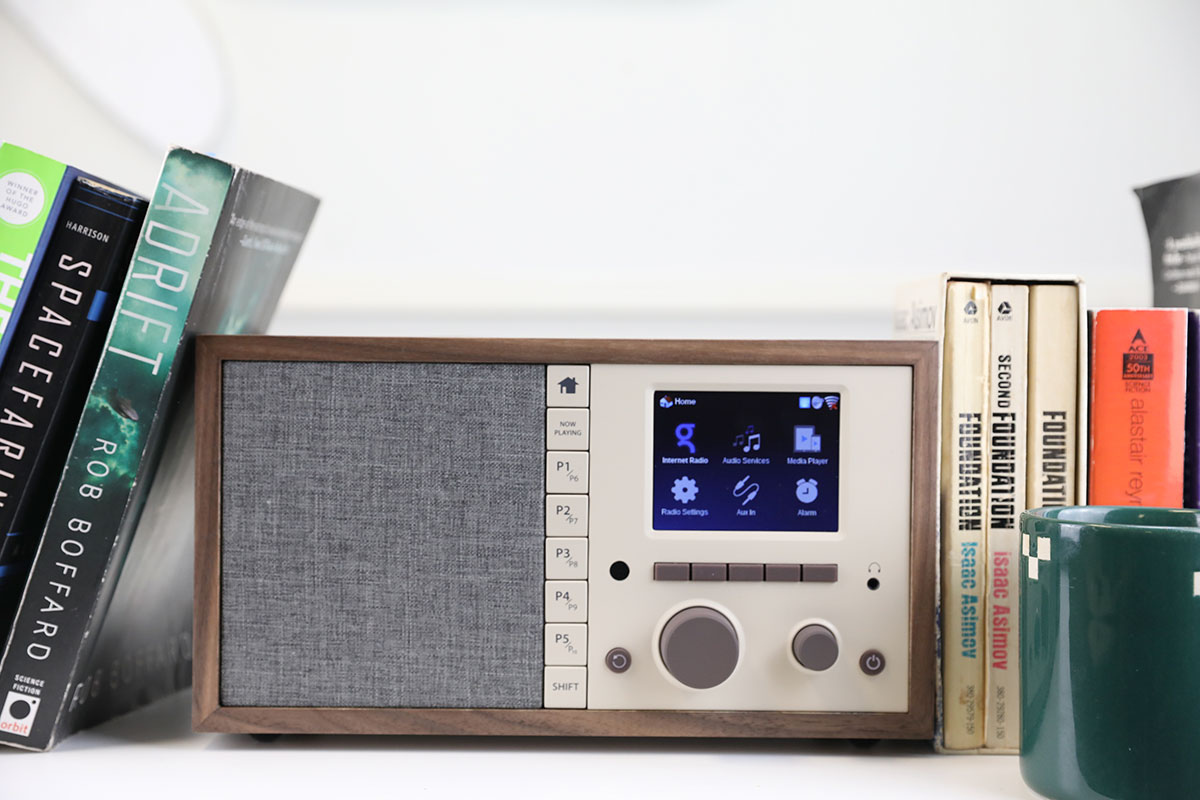
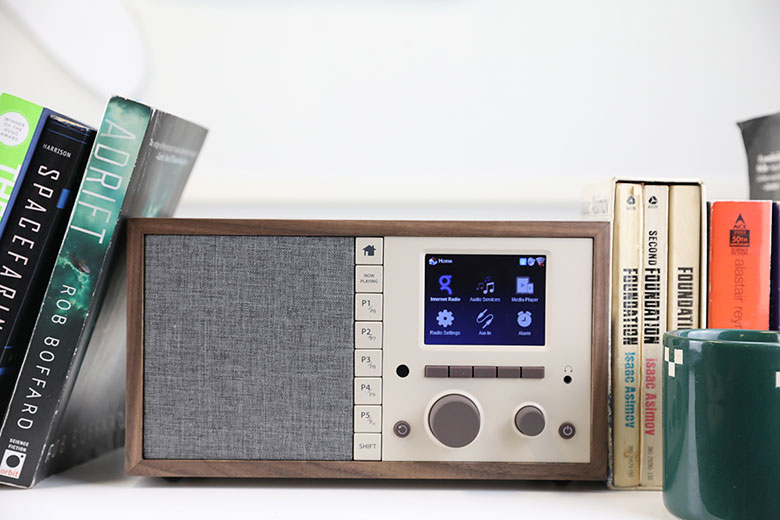
The Master Switch


The Master Switch
At a time when audio equipment is geared towards the future, you might think that the humble tabletop radio is extinct. Not even close. It's just evolved, and gotten a lot smarter over time. Radios now bear little resemblance to the dinky little clock radios from the past twenty years. As a bonus, they're not all that expensive - not compared to other examples of audio equipment, which can cost thousands of dollars. Even the most expensive tabletop radio costs considerably less than most other speaker categories. For more background, see our tabletop radio comparison table and buying advice below the picks.
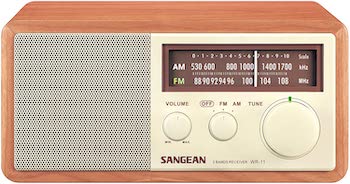 AM/FM: Both
AM/FM: Both
Bluetooth/Wi-Fi: None
Digital: No
What We Like: Clear and dynamic sound quality in a good-looking package.
What We Don’t: The lack of digital features may turn some people off.
You’d struggle to find a better all-around radio than the Sangean WR-11. It’s not only incredibly simple to operate, with controls a child could understand, but it offers clear and dynamic sound quality. The single speaker may be small—a mere three inches— but it offers surprisingly impressive sound quality, with good detail. The vintage looks and wooden housing disguise a cabinet that is carefully tuned, and really helps the sound quality along. If you’re looking for the absolute best in tabletop radios, look no further.
One thing to bear in mind is that there are no digital features at all on the Sangean WR-11. There’s no HD, no Wi-Fi, no Bluetooth. If you plan on listening to Internet radio, you may want to look at a model like the Tivoli Audio Model One below. It’s more double the price but has full digital compatibility. The WR-11 does, however, have an auxiliary input, allowing you to connect an MP3 player. And if all you want is a basic radio that performs exceptionally well, this is the one to go for.
See the Sangean WR-11
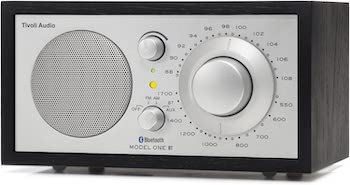 AM/FM: Both
AM/FM: Both
Bluetooth/Wi-Fi: Bluetooth
Digital: No
What We Like: Outstanding design with good Bluetooth implementation.
What We Don’t: We encountered a few issues with sound quality.
There are several radios that offer Bluetooth, but very few that do it with as much style or élan as the Tivoli Audio Model One BT. It’s an absolutely beautiful radio to look at, and connecting it to a Bluetooth device, like your smart phone, is simplicity itself. It’s much less expensive than similar Bluetooth models like the Como Audio Solo, and while it lacks some of the advanced features of those models, it makes up for it by doing a few simple things very well indeed. If you listen to both traditional AM/FM stations as well as Bluetooth audio, consider the Model One BT.
It is far from the best sounding radio here, however. In our opinion, the sound is passable, but can be a little harsh at times, especially when listening to AM/FM. For a better audio option, try the Grace Digital Mondo Elite Classic, below. Worth noting: Tivoli Audio make several variations of this radio, including a version with a clock, the Model Three, and a Wi-Fi-enabled version called the Model One Digital, both $300. We think the Model One BT is the best radio they make.
See the Tivoli Audio Model One BT
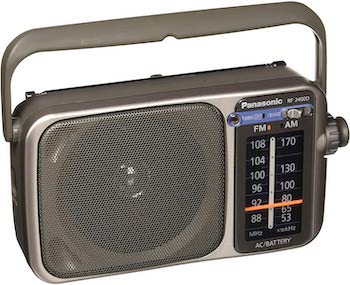 AM/FM: Both
AM/FM: Both
Bluetooth/Wi-Fi: None
Digital: No
What We Like: A solid, basic radio at a highly affordable price.
What We Don't: Poor looks, and channel hold issues may be an issue.
We think there’s a place for affordable tabletop radios, and the Panasonic RF-2400D definitely counts. For only $34, you get a very capable AM/FM radio with simple controls and good performance. The sound is surprisingly competent— nothing on similarly-priced radios like the Avantree SP850, below, but more than good enough to hold its own (and the Avantree is FM-only). If all you want is a simple, reliable radio that can pick up AM and FM stations in almost all circumstances the Panasonic RF-2400D is a good look. And although we haven’t had ours for very long, we’ve heard good reports about reliability— hardly surprising, given Panasonic’s reputation.
There are two issues that may discourage potential buyers. The first is the looks, which are utilitarian to say the least. The second is that several reviewers have reported issues with channel hold, which refers to the ability of a radio to stay locked onto a particular channel this can cause static to creep in. While we haven’t experienced this ourselves, it’s come up often enough that we think it’s worth mentioning.
See the Panasonic RF-2400D
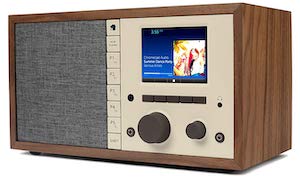 AM/FM: None
AM/FM: None
Bluetooth/Wi-Fi: Both
Digital: Yes
What We Like: Everything you could possibly want in a radio, even wireless charging for your phone.
What We Don't: Doesn't fix issues from its predecessor, won't suit traditional AM/FM listeners.
The Grace Digital Mondo Elite Classic offers everything you could possibly want in a radio. Whether you listen to an Internet station, or an AM or FM broadcast, you'll be up and running in seconds. The Mondo Elite Classic delivers excellent sound quality, too, thanks to a well-made 25-watt amplifier. It's not the loudest radio around, but for sheer quality and versatility, nothing can beat it. It even includes a Qi wireless charging pad, meaning you can drop your phone on top to charge. That's something not even more expensive radios, like the Bose Wave SoundTouch Music System IV, below, can boast. We love the design, too. The old Mondo Elite was an industrial hunk of plastic, but this has real warmth and flair, with a wonderful wood finish.
We do wish that Grace Digital had fixed the controls – there are still far too many of them, they are still a little confusing to use, and they still feel wonky when pushed. And there’s no AM/FM functionality. It’s possible to listen to stations on those wavelengths if they have an Internet broadcast, but less technologically forward stations may get left behind. That’s especially a problem if you’re an AM fan. Regardless, the Mondo Elite Classic gets almost everything right.
See the Grace Digital Mondo Elite Classic
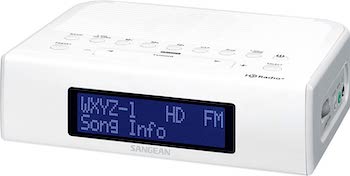 AM/FM: Both
AM/FM: Both
Bluetooth/Wi-Fi: None
Digital: No
What We Like: The only HD clock radio we’ve ever seen.
What We Don't: Surprisingly basic, with no advanced features.
If you want an alternative to the pricey Bose Wave SoundTouch Music System IV, we like the Sangean HDR-15. Not only does it offer HD audio, which is a nice plus, but it’s arguably the only HD clock radio currently available. That’s unique enough to earn it a spot on the list, and it sounds good enough that we think it’s a worthy alternative to the far more expensive Bose system above. It’s hardly surprising that the challenger comes from Sangean, who really do make some spectacular and spectacularly affordable products.
The most glaring downside with the Sangean HDR-15 is the lack of features. There’s no Bluetooth or Wi-Fi at all, and despite the handy display, the functionality here is very basic. You can’t even use an external antenna if your reception happens to be poor. It’s not the best radio that Sangean make— that would be the WR-11, above— but it’s an excellent challenger to more expensive models, and a worthy alternative.
See the Sangean HDR-15
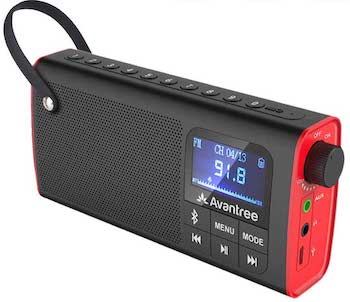 AM/FM: FM Only
AM/FM: FM Only
Bluetooth/Wi-Fi: Bluetooth
Digital: No
What We Like: Good all rounder with auto search, Bluetooth and SD card playback.
What We Don't: FM only, and the build feels slightly flimsy.
The Avantree SP850 is a popular little desktop radio, perfectly suited for the kitchen or workshop. It features a rechargeable battery and, being roughly the size of an iPhone, it can be taken virtually anywhere. Avantree have focused their efforts on user-friendly features such as auto-scan and one of the easiest ways to manually search stations. The ten large buttons with numbered slots not only make saving a favorite station a breeze, but also act as a smart dial. Just punch in 1022 to tune into 102.2 FM, for instance.
The SP850 packs in Bluetooth, and even a TF card reader. These features are welcome, but the SP850 is still very much a budget option. This is reflected in the build, which is plasticky, and feels cheap. We wouldn’t recommend dropping this radio from a height. There’s also no AM functionality, which may be a problem if you prefer to listen to stations on that wavelength. Regardless, in our opinion, the Avantree SP850 offers good features and sound for the money, and is an ideal budget choice.
See the Avantree SP850
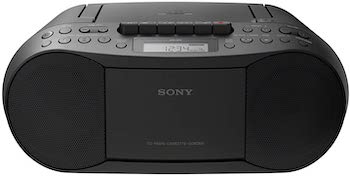 AM/FM: Both
AM/FM: Both
Bluetooth/Wi-Fi: None
Digital: No
What We Like: Full stereo sound, in contrast to the many mono radios on this list.
What We Don't: Volume is slightly lower than we would like.
The Sony CFDS70 does something that almost all other models on this list don’t. It has two speakers, meaning that it can produce stereo sound; almost all other models have only a single speaker, and produce mono audio. This stereo sound means that the audio quality here is much more realistic and interesting than other radios. That’s great if you value good audio quality, and while it may not have advanced features, the CFDS70 store performs the basic functions very well.
The CFDS70 is surprisingly small, however, and doesn’t get nearly as loud as models like the Avantree SP850, which is more affordable. It’s also worth noting that it includes a CD player and a tape deck, features that may be obsolete for many people. They are nice to have, but most of us will simply never use them, and of course those features factor into the price. The CFDS70 definitely has its pluses, though, and it earns a spot on this list.
See the Sony CFDS70
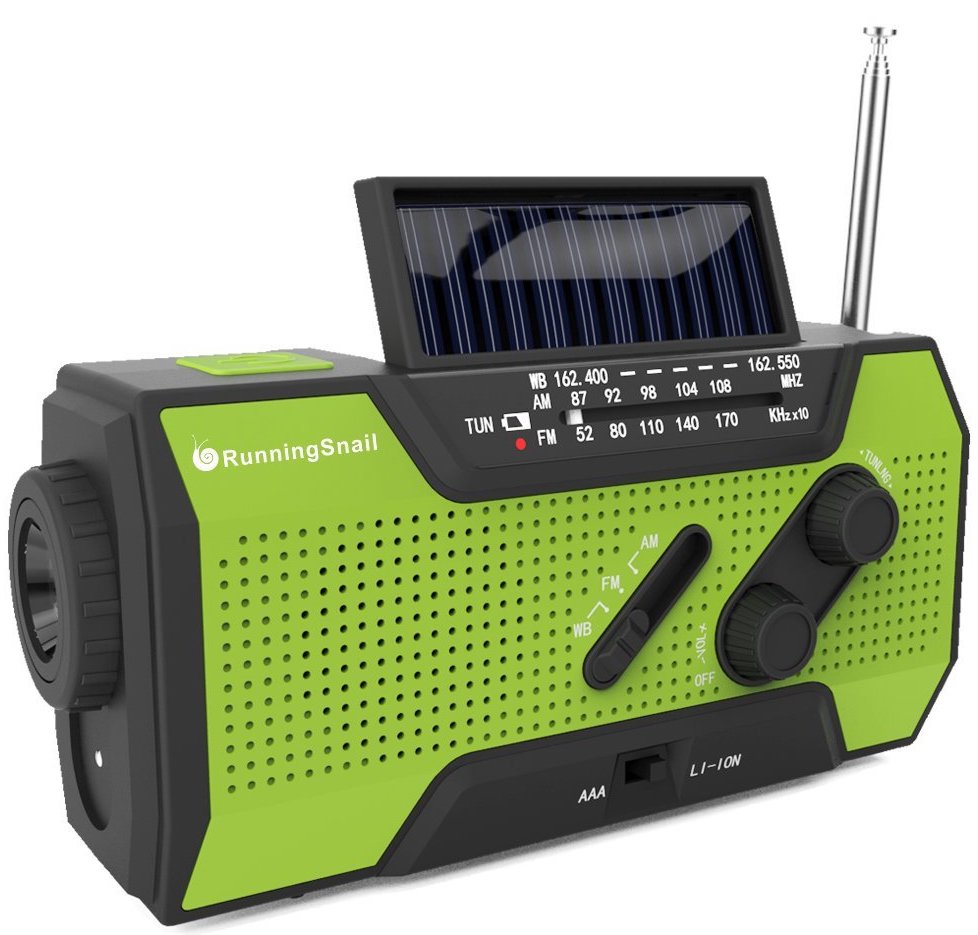 AM/FM: Both
AM/FM: Both
Bluetooth/Wi-Fi: None
Digital: No
What We Like: Incredible outdoor tool with its solar charge, power bank and lots more.
What We Don't: Audio quality is average.
This might seem like an odd choice for one of our top five radios, but if you ever happen to find yourself in one of those zombie flicks, in a city undergoing a power cut...this little radio will still be able to pick up the emergency broadcasts. In more realistic terms, if you just happen to be at the beach, sailing boat, local park or your front porch, this fine NOAA (National Oceanic & Atmospheric Administration) device will keep chirping away all day long - on account of its solar power self-charging. Its ability to be also charged by hand winding (as well as AAA batteries) is useful, too. A minute of hand-cranking gives you 15 minutes of broadcast.
What's more, this little radio also acts as a power bank (2000mAh) with an included 4-in-1 USB cable with lightning port, 2 micro-USB and 30 pin connections. That alone makes it a must-have for music festival lovers. Aside from the survivalist kudos, the NOAA radio sports a jolly 80s vibe. You'll be limited to AM/FM bands only, and of course frequency tuning is manual - the old fashioned way. Audio quality is decent enough - no thundering bass or audiophile clarity, but the Running Snail still manages to get a loud enough background playback and there are no major sonic issues. If you live in Florida or anywhere near hurricane weather this is the perfect companion - its third WB (VHF weather band 162.400-162.550) picks up the governmental emergency bulletins.
See the Running Snail NOAA Radio
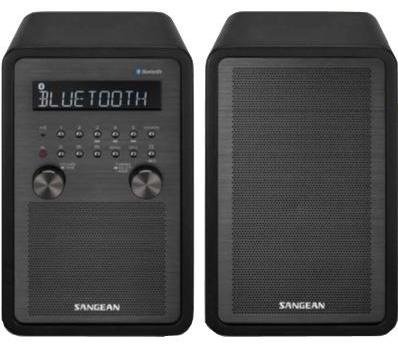 AM/FM: Both
AM/FM: Both
Bluetooth/Wi-Fi: Bluetooth
Digital: No
What We Like: Much better than the old WR-11, good stereo functionality.
What We Don’t: Doesn’t quite do enough to separate itself from the crowd.
We’ve got a lot of love for stereo tabletop radios, with one master speaker and one slave speaker. They offer a convenient and fun way to get stereo sound, and Sangean’s WR-50P offers an excellent way to do this. It’s not the most exciting radio on the list, by a long shot – you get AM/FM, and Bluetooth, and that’s about your lot – but it’s definitely a better buy than something like the SPARC SHD-BT1, which is definitely a downgrade in terms of features and audio quality.
We love the usability and functionality here, as well as the crisp sound, thanks to well-made digital signal processing circuitry. You get a decent remote, a good range of features, and generally, nothing you wouldn’t expect to see in this particular price range – although, for the record, we think this is a touch overpriced right now. Having said that, you can always opt for the mono option, which sacrifices the slave speaker (God, that sounds ominous) and offers just the one speaker at a cheaper price. It’s good to know there are options.
See the Sangean WR-50P
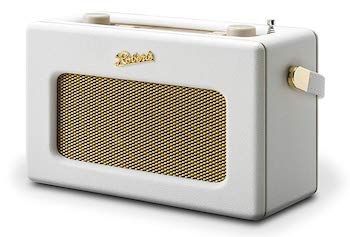 AM/FM: FM Only
AM/FM: FM Only
Bluetooth/Wi-Fi: Both
Digital: Yes
What We Like: Seriously cool retro looks matched with excellent sound.
What We Don't: Hard to track down.
Roberts makes some of the coolest radios we've ever seen, and our current favorite is the Revival iStream 3. It's not the newest model they offer – technically the Stream 94i is newer. But that model costs the same as this one, and there's no question as to which one we prefer. The Roberts Revival iStream 3 crosses the line between smart wireless speaker and traditional radio, with Amazon Alexa included. You get an FM radio, as well as full digital functionality. But we'll be honest, the appeal here lies in the pleasingly retro looks matched with powerful sound quality. We don't have a listing for watts per channel, but we were satisfied with how loud this radio played.
The downside? Although it is available in the United States, to the best of our knowledge, it can sometimes be a struggle to track down. That's deeply annoying – would it really be so difficult for Roberts to list this radio on Amazon? Especially given the Alexa inclusion. All the same, if you can find one (check your local hi-fi store) it's well worth your time.
See the Roberts Revival iStream 3
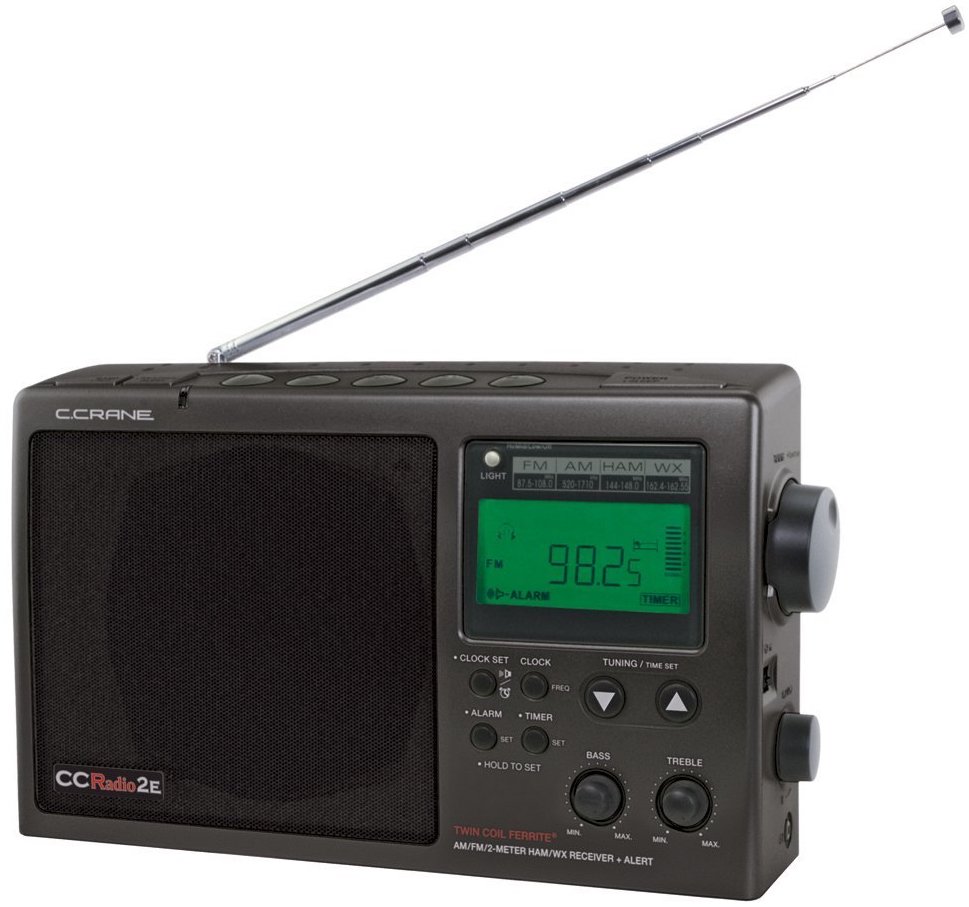 AM/FM: Both
AM/FM: Both
Bluetooth/Wi-Fi: None
Digital: No
What We Like: Long distance AM signal holds champion, good sound.
What We Don't: Features focussed for AM band listeners.
Tthe C.Crane CC 2E offers a staggering performance for the price. Staggering not in terms of audio quality, but in selectivity (often called sensitivity) and sync hold - the ability to hold steady onto a frequency band. The fact that it can ‘hear far’ also makes it invaluable if you enjoy regional broadcasts. In our buying advice section, we talk about synchronous radio circuits which employ a dual antenna - the CC 2E is equipped with this and it’s the reason for its incredible ability to lock onto signals, especially when operating in AM band.
With its primary purpose being a long-range AM radio, it’s got to be said that C.Crane’s FM performance is impressive in terms of level, voice intelligibility, and top end detail. Both music content and speech broadcasts sound clear when compared to lesser radio units, and the bass/treble controls can make a tremendous difference to a dull signal. In terms of specs, you get a lot for your money: plenty of buttons to save your favorite stations and of course, headphone and line outputs. If you live near areas with difficult weather conditions, the C.C Crane CC 2E might be the radio for you.
See the C.Crane CC 2E
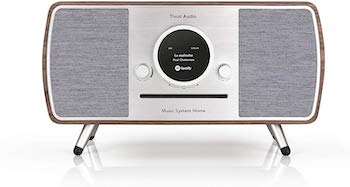 AM/FM: Both
AM/FM: Both
Bluetooth/Wi-Fi: Both
Digital: Yes
What We Like: Now with AirPlay and Chromecast.
What We Don't: The price jump may be too much for most people.
If you’re in the market for a high-end radio, and want to put down some serious cash, then we recommend the Tivoli Audio Music System Home Generation II. It’s an absolutely extraordinary machine, part radio, part smart speaker, with just about every feature you could possibly want. The whole is wrapped up in an absolutely beautiful wood and fabric finish. This model is the newer version (obviously) and it now adds Apple AirPlay and Chromecast to the mix. This makes it one of the most fully featured radios ever released.
However, while we see the inclusion of AirPlay and Chromecast as a serious positive, the Tivoli Audio Music System Home Generation II has one black mark. It costs almost a hundred dollars more than the first generation model, and outside of the aforementioned streaming options, there is virtually no difference between the two. We think that something like Chromecast is enough of a game changer to warrant the price upgrade, but we can absolutely see how it would be too big a leap for most people. If you want to enjoy the Music System Home without using these options, then you can quite happily buy the original. It’s been out for long enough that you may even score a discount…
See the Tivoli Audio Music System Home Generation II
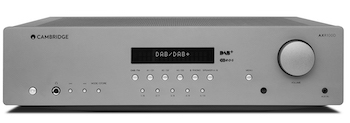 AM/FM: FM Only
AM/FM: FM Only
Bluetooth/Wi-Fi: Bluetooth
Digital: Yes
What We Like: Ideal for more advanced hi-fi setups that need radio.
What We Don't: You’ll need additional speakers.
If you have an existing hi-fi system, and want to include radio in the mix without adding additional boxes, then we strongly recommend the Cambridge Audio AXR100D. The British company makes some of the best amplifiers on earth, and with this one, they’ve added in FM and digital radio. That means you can listen to the radio via your hi-fi speakers. It makes the system unique among the other tabletop radios here, as none of them are compatible with additional speakers— you’re stuck with what you get. That’s not the case here, and it’s a refreshing option to have.
The biggest downside with the Cambridge Audio AXR100D is not very surprising. It’s an excellent radio, but you will need those additional speakers. That can mean a substantial outlay, depending on how much additional sound quality you’re looking for. You’ll find several options for speakers, both budget and, in our list of the best bookshelf speakers. This does mean that the AXR100D may not be the best option if you’re looking for a single box solution, but we think it’s worth including here.
See the Cambridge Audio AXR100D
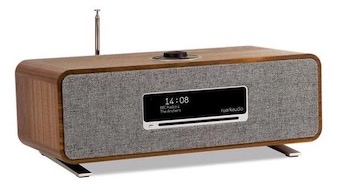 AM/FM: FM Only
AM/FM: FM Only
Bluetooth/Wi-Fi: Bluetooth
Digital: Yes
What We Like: Beautiful design with outstanding sound quality.
What We Don't: Gigantic pricetag.
We don’t think we’ve seen a more beautiful tabletop radio than the highly capable Ruark R3. The wood and fabric housing matched with a surprisingly crisp black-and-white screen makes this one a real looker, easily more attractive than less expensive models like the Bose Wave Music System IV. We also happen to think that the R3 sound significantly better, with the rich and powerful audio. You get a full suite of radio tools, including digital radio and FM, plus Bluetooth and Wi-Fi streaming. That means you can listen directly from Spotify, as well as your favourite radio stations.
But there’s no question that the Ruark R3 cost a pretty penny. At $815 at the time of writing, it’s about the most expensive tabletop radio here. Those looking for a simple, good sounding radio that doesn’t require taking out a second mortgage may want to look at something like the Como Audio Solo, which is less than half the price. If you can afford it, however, you get to experience one of the best tabletop radios on the planet. Lucky you.
See the Ruark R3
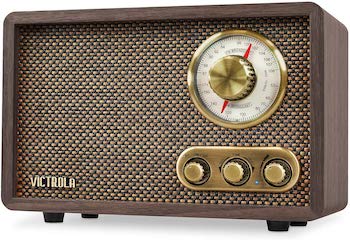 AM/FM: Both
AM/FM: Both
Bluetooth/Wi-Fi: None
Digital: No
What We Like: Terrific old-school design, decent sound quality.
What We Don't: Sacrifices features for aesthetic design.
We have a soft spot for retro radios, and the Victrola Retro Wood really tugs at our heartstrings. It matches a wooden finish with glorious retro details, like an oversized rotary selector. We think it’s one of the best ways to give your home a touch of the 1920s – at least in a really good way. It also helps that, despite the relatively low price, the sound quality is surprisingly lively.
However, there’s no denying that the Victrola is mostly about the looks. This is most obvious when compared to the Avantree SP850, which comes with an identical price tag and offers full Bluetooth streaming. While the Avantree doesn’t look anywhere near as good, we think it’s a better buy for most people. However, if you put a lot of emphasis on style, then the Victrola is worth looking at. It replaced the tiny Muzen OTR on this list, which is a similar retro radio that’s no longer available.
See the Victrola Retro Wood
| Tabletop Radio | Price | AM/FM | BT/Wi-Fi | Digital | HD | Power |
|---|---|---|---|---|---|---|
| Sangean WR-11 | $103 | Both | None | No | No | 6.5 Watts |
| Tivoli Audio Model One BT | $200 | Both | Bluetooth | No | No | Unavailable |
| Panasonic RF-2400D | $27 | Both | None | No | No | Unavailable |
| Grace Digital Mondo Elite Classic | $220 | None | Both | Yes | Yes | 25 Watts |
| Sangean HDR-15 | $70 | Both | None | No | No | Unavailable |
| Avantree SP850 | $30 | FM Only | Bluetooth | No | No | Unavailable |
| Sony CFDS70 | $180 | Both | None | No | No | Unavailable |
| Running Snail NOAA Radio | $30 | Both | None | No | No | Unavailable |
| Sangean WR-50P | $196 | Both | None | No | No | Unavailable |
| Roberts Revival iStream 3 | $260 | FM Only | Both | Yes | No | Unavailable |
| C.Crane CC 2E | $180 | Both | None | No | No | Unavailable |
| Tivoli Music System Home Gen. II | $850 | Both | Both | Yes | No | Unavailable |
| Cambridge Audio AXR100D | $569 | FM Only | Bluetooth | Yes | No | 100 Watts |
| Ruark R3 | $815 | FM Only | Bluetooth | Yes | No | 30 watts |
| Victrola Retro Wood | $60 | Both | None | No | No | Unavailable |
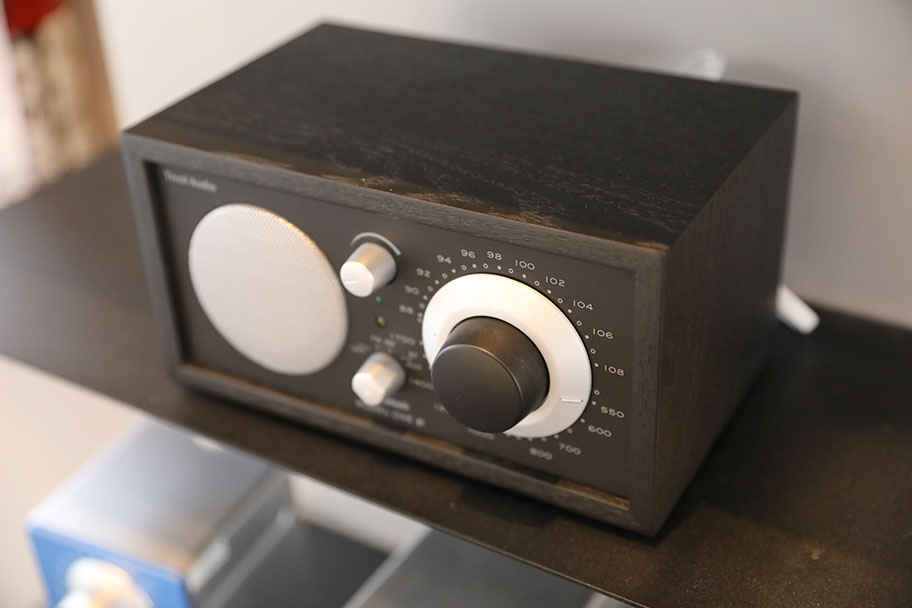
The sound quality question is a good one. It’s quite a subjective one, too, but not one without an answer. Sound quality in any set of speakers, or any amplifier, comes down so many factors: driver size, driver construction, the type of amp circuitry, how it handles power. The environment you put it in. But generally speaking: tabletop radios don’t match separate speakers for sound quality. We know that probably isn’t what you want to hear, and it’s probably being a little bit unfair to some of the radios on our list, particularly at the top end. But it’s also the truth. A dedicated system with discrete speakers and an amp is always going to outdo a single, in-the-box system (at an equal price). Too many compromises have to be made. So generally speaking, you shouldn’t expect audiophile grade sound from your radio. That isn’t always a clear rule – models like the Bose Wave Music System IV very much hold their own against bigger systems – but it’s a good rule of thumb.
Should you let that stop you? Of course not. Not everybody needs audiophile grade sound, and the quality of the radios we mentioned is always adequate, frequently good, and occasionally spectacular. If you can, try before you buy to get a feel what kind of radio you should go for, and if you do want something a little bit more hefty, and with better sound, you should check out our lists of the best bookshelf speakers and stereo amps.
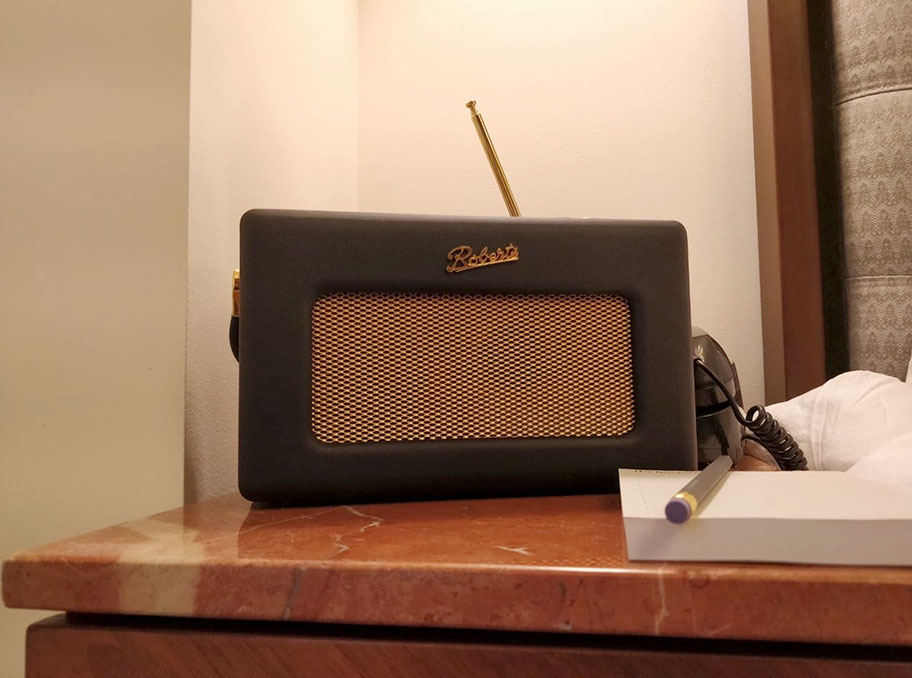
This is the bedrock of radio. You may not need it…but if the radio you choose offers it, you’ll be very glad to have it. FM refers to an analog method of broadcasting audio on a particular band of the frequency spectrum. What that means, in practice, is that you have to be in the transmission area to hear it, with a receiver tuned to the correct FM signal. Until Digital Radio became a reality, FM was your best bet for a quality radio playback, not only because of the more powerful and clearer signal, but also because its transmission were universally in stereo - something we’ll talk about in more detail below.
Plenty of radios on this list offer FM functionality, to go with their regular streaming options. In addition, you should (in theory) be able to listen to any FM station but also broadcasts its audio online. For example, the Como Audio Solo allows you to snag FM stations, along with regular digital functionality. Even if you lose your wireless signal, you’ll still be able to get audio through the FM band. Yes, some radios still carry the option for you to listen to analog AM stations. Are there even AM stations? Do they exist any more? Anyway, it stands for Amplitude Modulation, and is used to refer to signals in the broadcast range of 535-1605 kHz. These stations are usually crackly, sometimes inaudible, and almost exclusively local programming, as any station can afford it will be on the more powerful FM band.
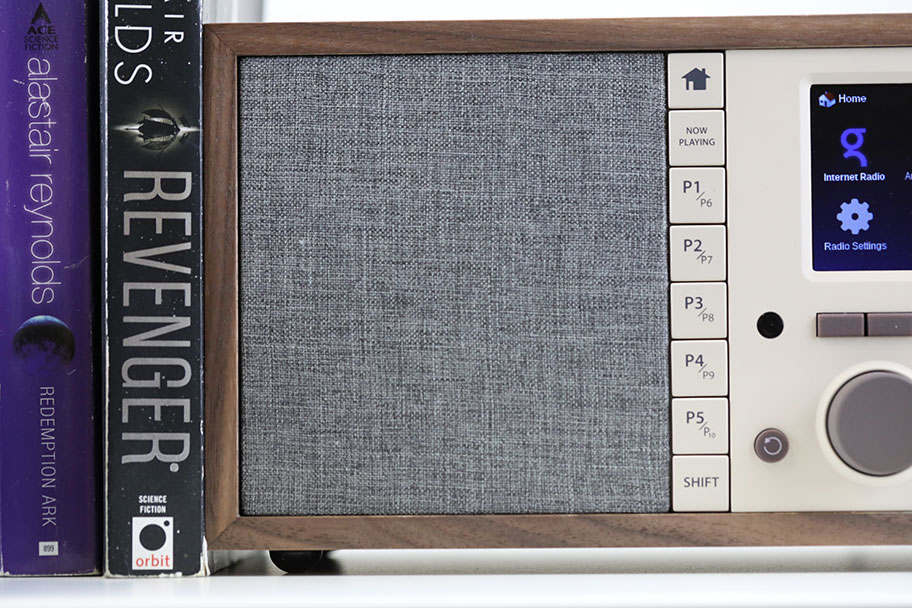
Given how far technology has come, it’s hardly surprising that Bluetooth audio is now a regular feature in the world of tabletop radios. It can be incorporated very easily, meaning that even inexpensive radios can offer it. It’s great to have, especially if you want the alternative to listen to streaming services like Spotify via your smartphone.
But to repeat something we’ve said already: Bluetooth audio can be incorporated very easily. That means it’s simple for companies to tack it on without giving a second thought to it. If you’re going to buy a radio with Bluetooth functionality, then it pays to choose one that has given particular attention to making the experience smooth, and the sound crisp. Bluetooth audio is different to AM/FM streaming, and needs to be treated differently. We recommend something like the $150 Tivoli Audio Model One BT, which puts Bluetooth audio first.
Wi-Fi functionality is also a fairly recent addition to the world of radios. It means you can directly access digital radio and online stations direct from the radio itself. However, the inclusion often means that the price goes up, so it’s hardly surprising that the radios that offer Wi-Fi on our list are usually pretty expensive. We think the best option right now is the Grace Digital Mondo Elite Classic. We think having Wi-Fi functionality can be hugely useful, but you need to make sure that you’re actually going to use it. Otherwise, you could be spending a lot of money needlessly.
Digital radio is a method of transmitting the audio by digital means, as opposed to analog FM or AM signals. It can be transmitted on cable channels, as a podcast, or by satellite. Any streaming station you find online can also be called internet radio. Tabletop radios that offer this require a Wi-Fi connection. Tabletop radios can feature different chipsets, allowing the decoding of several types of digital audio. What that means is that it’s become something of a blanket term, slightly amorphous, generally used to refer to anything that isn’t FM or AM. Above around $200, almost all tabletop radios will feature digital audio, and in general, we think it’s a very pleasing development. Obviously it’s up to the manufacturers to decide how much emphasis they put on this, but if you take a look at things like the Tivoli Audio Model One Digital, you’ll find that digital radio is very much front and center.
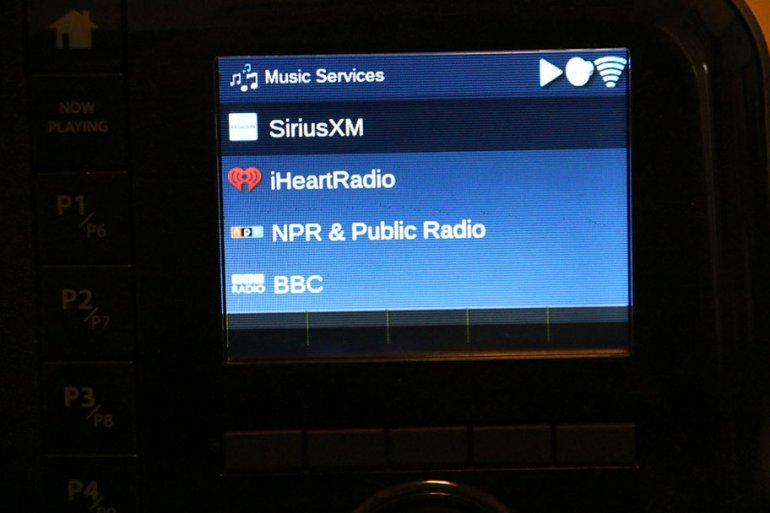
This is a little more complicated. In effect, HD Radio broadcasts analog and digital material simultaneously, but the name “HD Radio" stands neither for "High Definition" nor for "Hybrid Digital". It is in fact a trademarked term for an in-band on-channel (IBOC) - a digital radio technology that can be used both by AM and FM radio stations to transmit audio and data simultaneously. By using a digital signal embedded “on-frequency” immediately above and below a station's standard analog signal, the same program can be broadcast in either HD (digitized audio and with less noise, as the FM HD mode uses a high quality codec called MPEG-4 HE-AAC standard), or as a standard broadcast analog radio with standard sound quality). Not only are the two (analog and digital) beamed at the same time, the HD format allows a single radio station to simultaneously broadcast one or more different programs in addition to the program being transmitted on the radio station's analog channel.
We are not only talking about audio transmission, when it comes to the above-mentioned additional embedded digital material, as this could be data as well. For instance, HD Radio offers a service called Artist Experience. This allows playbacks to include the transmission of artist and track name, album art, logos and other artwork, which can be displayed on (the optional) radio screen. Perfect example of this: the Grace Digital Mondo Elite Classic, a tabletop radio the displays a huge range of information, and offers full HD capability. We rather like it.
You'll notice in our table above that we have a listing for wattage. Let's keep it simple. Wattage is the amount of power the speaker or radio will put out. It's not quite the same thing as loudness, which you can, after all, change by tweaking the volume knob, but it's a rough analogue. If one speaker has 10 watts of output power per channel, and another has 20, and they are both at roughly the same volume level, then the one with 20 will make a louder noise. When we have wattage stats for the radios, they're measured in RMS, which is how much power the radio can put out over a long period - as opposed to peak or dynamic wattage, which is the absolute max it can put out in one short burst before it goes bang!
You'll notice that we can't give many wattage figures for the radios on our list. That, sadly, is deliberate - in most cases, manufacturers just don't give them. It's annoying as hell, and happens for many reasons, the most common being that they don't believe they can compete with dedicated, more powerful hifi systems. Our take? Wattage is useful, but not essential to know. Other features will give you a better idea of which radio is for you. The Cambridge Audio AXR100D is the most powerful that we know of, at 100 watts.
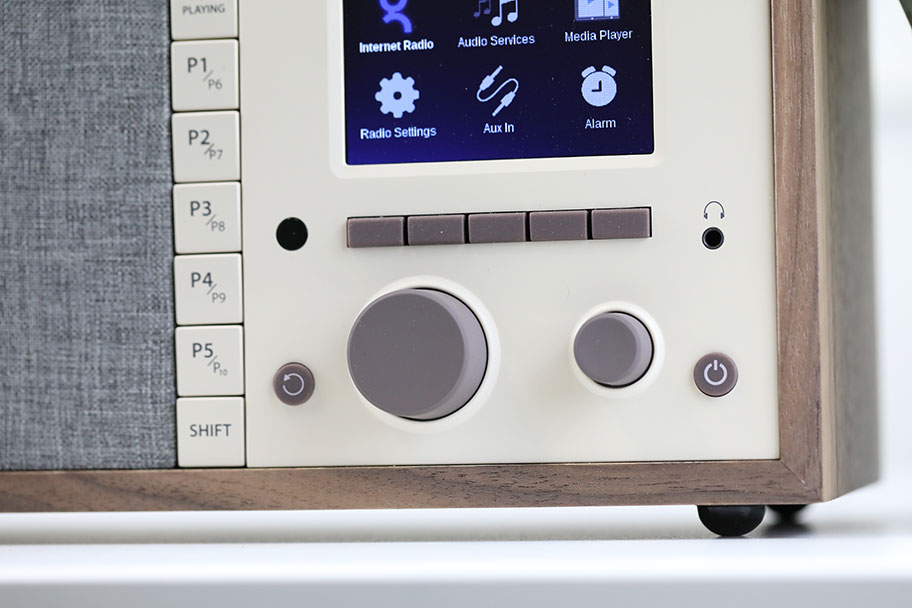
OK, yes, we know these are technically tabletop radios, but there’s no reason why they can’t be portable as well. Being able to take your radio with you can be a huge advantage, as it means you are never far from your favorite stations. However, there are a couple of things to bear in mind before you choose a portable radio.
The first, somewhat obviously, is weight. A portable radio should be light and small, as well as robust. It should be able to be slung into a bag and forgotten about. While you may get slightly less volume and perhaps less clear sound quality, you more than make up for it in terms of convenience. There are several radios on our list that we think are light and small enough to be portable. Try the Sony ICFP26 as a basic option.
And speaking of features: one thing we recommend going for, if possible, is a radio with Bluetooth functionality. AM and FM signals can be powerful, but also have a habit of fuzzing out of the worst possible moments. If you have a radio with Bluetooth, you can connect directly to your mobile device, which may have a stronger data signal. It means you never have to be without your music.
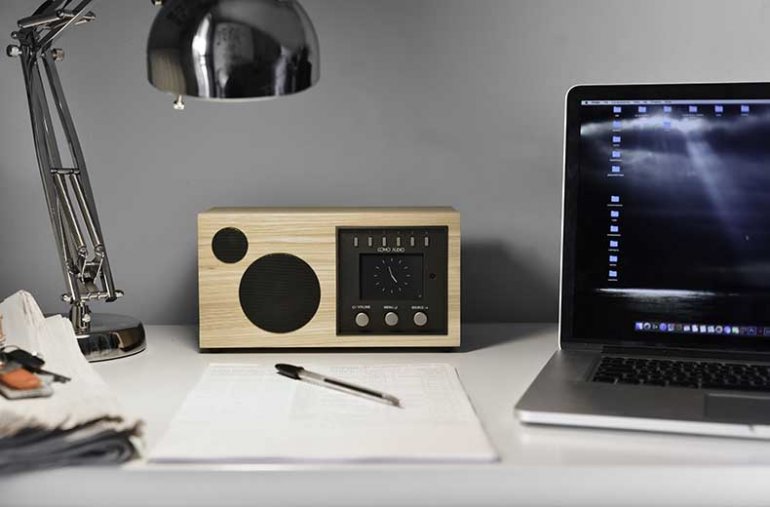
At its most simple, a tabletop radio is a small model music station designed to fit unobtrusively on a desk, bookshelf, or bedside table. It is distinct from other radios, which may be part of a larger sound system. It’s also definitely distinct from larger speaker systems, which usually have separate amplifiers, receivers and speakers – and which almost always require a separate sound source, like a smartphone or turntable. A tabletop radio will be a fully self-contained unit, with speakers, receiver and power source all packed into one box. Unlike portable radios, it’s actually quite rare to have a tabletop radio that runs off a battery. They almost always require mains power, so factor that in when you buy.
It might be a little surprising to see us doing a breakdown of radios in this day and age. Maybe even a little bit old-fashioned. The fact is, radio is stronger than ever, particularly digital radio, and with the growth of things like podcasts, more and more people are looking to get a self-contained unit specifically designed, or at least predominantly designed, for radio. All these models still sell incredibly well, and plenty of new companies and trying to get in on the market. What was saying is, if you're looking for a radio, you have a huge amount of choice.And of course, these are often way more than simple radios. Several models come with the ability to tune into Internet stations, play music wirelessly and connect with larger systems. What is excellent about them is that they offer good sound quality and good feature sets for a very reasonable price. It's also worth noting that you do occasionally see CD players on these models, although none of our picks above have this feature. It's getting much less common these days, when so much music is listened to on a streaming media rather than a physical one. Kind of a shame, but not a deal breaker for the majority of people.
It's also worth mentioning that tabletop radios are occasionally known by different names. We've seen them called bedside radios, and even clock radios, which is a term we thought had died out in the mid-90s. What we’re saying is, these aren't different products; they are one and the same, and you shouldn't let names distract you when you're shopping for one. Don't forget: sometimes just because you want to listen to the radio doesn't mean everybody else does. You might also want to check out a pair of headphones, too.
One of the most frequent questions we get here at TMS is whether a particular radio will pick up a certain local station. It’s one of the most common, but also one of the hardest to answer. Although different radios have different reception strengths, it is, for the most part, much of a muchness. Reception and signal quality is far more likely to be affected by the radio's surroundings, rather than the radio itself. And as for whether your particular radio will be able to the tact a station in your area… That’s entirely down to the station! But as a general primer, radio is split up into two types: the more common FM, and the slowly-dying AM. We’ll go into these in more detail below, but FM signals, which are what most terrestrial stations use these days, have a slightly limited reception range – often no more than the horizon – while AM signals can travel for huge distances, thanks to being able to bounce off the ionosphere. This is a roundabout way of saying that there is no way of us being able to tell whether a radio can pickup your local station. The easiest way to figure that one out is to ask! Obviously this doesn’t apply to stations that stream over Wi-Fi. All those need are a router.
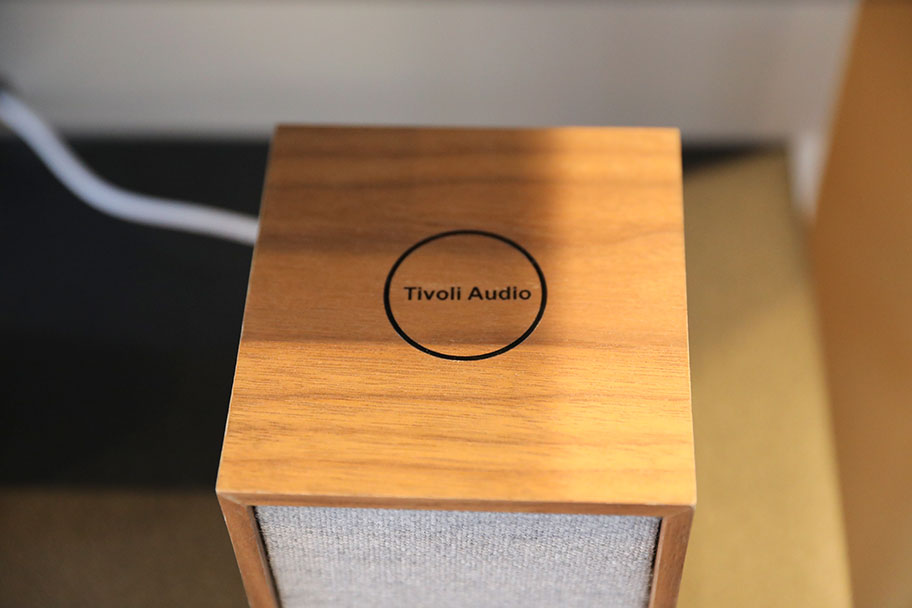
Don’t be put off if you see DAB offered, without any mention of digital radio. This is because they’re the same thing. In Europe or Asia, digital radio is called DAB, and it refers to Digital Audio Broadcasting. It’s functionally the same as digital radio, with a bunch of preset channels you can switch to without having to tune. Often when speaking of DAB, this is a reference to digital radio’s original or first generation. The typical digital quality, or bitrate to be precise, for DAB programs is somewhat lower than your average Amazon or iTunes download, at around 128 kilobits per second, and as a result, most radio stations on first-generation DAB have a lower sound quality then even what FM has. Not only that: due to this severe quality compression, digital broadcasts may further ‘downgrade’ the original audio’s stereophonic sound to mono, which is far from cool for audio material designed to be listened to in stereo.
Such audio quality issues have lead to a DAB update, called DAB+, which uses a different way of digitizing analog audio which uses a higher resolution (with the AAC+ codec). You may also see DRM (also known as Digital Radio Mondiale or DRM 30). It’s similar to AM HD Radio, and is designed primarily for digital shortwave radio programs for compatible radios already available for sale. Just like HD Radio, DRM also allows for the transmission of analog signals combined with digital data (also known as hybrid digital-analog broadcasts) or of course, of pure digital broadcasts.
DRM+ (confused yet?) is another digital radio system, but closely based on the DRM30. Instead of operating in HF digital shortwave though, it uses the VHF band. Although reception can be problematic, DRM+ allows for fairly high quality digital broadcasts as it has a high streaming capacity (up to 700 kilobits per second data rate).
Another very common question that we get asked: can I pick up my favorite podcasts / public radio / satellite radio on my new purchase? It’s a little bit difficult to answer. Every model is different, and every model will give you access to a wide variety of audio sources. If we were to list every single thing that each radio on our list had access to, it would be a very long and very boring list! To save time, we’ve chosen to simply indicate if a radio has HD and/or Digital functionality.
But the good news is that if the radio you’ve chosen does, there’s a very good chance you’ll be able to get your preferred listening material onto it. Take, for example, the Grace Digital Mondo Elite Classic. It offers just about any radio service you can think of, including direct access to things like NPR, Sirius XM, the BBC and iHeart Radio – as well as thousands upon thousands of searchable podcasts. The easiest way to find out if the radio you’ve got your eyes on actually connects to your favorite service is to check out its Amazon page. You can do that by clicking on any of the product links in this roundup.
Think of this in terms of channels. An audio system that has two channels – a left one, and the right one – is considered to be a stereo system. As almost all music these days comes in stereo format, a stereo system can showcase slight differences between the two channels, meaning that you’ll get a wider spread of instruments, and a more lifelike experience. This is true of stereo radios as well, and several of the models on our list offer this, particularly at the top end.
But there are plenty of mono radios available, too. These combine both the left and right channels into a single one – whether for reasons of keeping the price down, or for electronic simplicity, or simply for mimicking the effect of old-school audio. While we at TMS greatly prefer stereo sound, we know there are plenty of people who like mono audio as well.
One of the best things about radios from the 40s, 50s and 60s, and even up to the 1970s, was the presence of vacuum tubes in their interiors. Whenever you hear someone reminiscing about how good old school radios used to sound, chances are they’re talking about these vacuum tubes. These are literal enclosed glass cylinders, which are still used in a variety of amps today, that burn off electrons, and in doing so, dramatically color the sound. Any piece of audio equipment that runs its audio through a series of vacuum tubes is guaranteed to have sound that is warm, rich, lush and full, with a characteristic squashiness to the low end. Although it’s not to everyone’s taste, especially these days, where a lot of music doesn’t always respond well to it, it’s absolutely fantastic when listening to things like old-school soul.
Now for the bad news. To a large extent, vacuum tubes have been phased out of modern radios. They are just too temperamental, too finicky for most people to deal with. Servicing them and swapping them out can be a real pain. As such, it’s very rare to actually find radios that use them. One of the few radios that have it - not featured on this list, as it's tough to find - is the Tesslor R601. Up until very recently, it was arguably the best tube radio in production, but at the time of writing, it no longer appears to be for sale anywhere – even on eBay! That’s a real shame, and we hope that a manufacturer (Como, perhaps?) gives vacuum tubes another go at some point in the future.
This is not a question we have a satisfactory answer to - it's something that's vexed us for quite some time now. Every time we go to update this piece, a good deal of the tabletop radios we want to include - models that have wowed us - turn out to only be available in Europe. These include real gems from the likes of Pure, ViewQuest, The+Radio and Ruark. Their radios have either very limited stateside distribution, or are simply not available here at all. One of the curious things about writing these lists on TMS is that we struggle to justify including models that aren't available for US readers to buy. As good as they are, adding them would simply be an academic exercise!
There are a couple of models that we would strongly recommend you check out if you are ever on the other side of the pond. Right now, one of our favorites is the Pure Elan E3, a gorgeous radio with an excellent range of features and absolutely delicious sound. We also have a soft spot for the The+Radio DAB+ Stereo. It may have a completely loopy name, but it has a great design, with twin speakers that look and feel fantastic.
Back To Our Tabletop Radio Picks Back To Our Comparison Table